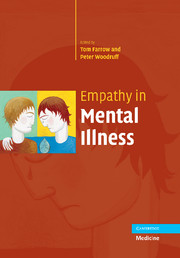Book contents
- Frontmatter
- Contents
- Foreword
- List of contributors
- Part I ‘Dysempathy’ in psychiatric samples
- 1 Empathic dysfunction in psychopathic individuals
- 2 Empathy deficits in schizophrenia
- 3 Empathy, antisocial behaviour and personality pathology
- 4 Empathy and depression: the moral system on overdrive
- 5 Empathy, social intelligence and aggression in adolescent boys and girls
- 6 Impaired empathy following ventromedial prefrontal brain damage
- 7 Non-autism childhood empathy disorders
- 8 Empathy and autism
- Part II Empathy and related concepts in health
- Part III Empathy models, regulation and measurement of empathy
- Index
7 - Non-autism childhood empathy disorders
from Part I - ‘Dysempathy’ in psychiatric samples
Published online by Cambridge University Press: 17 August 2009
- Frontmatter
- Contents
- Foreword
- List of contributors
- Part I ‘Dysempathy’ in psychiatric samples
- 1 Empathic dysfunction in psychopathic individuals
- 2 Empathy deficits in schizophrenia
- 3 Empathy, antisocial behaviour and personality pathology
- 4 Empathy and depression: the moral system on overdrive
- 5 Empathy, social intelligence and aggression in adolescent boys and girls
- 6 Impaired empathy following ventromedial prefrontal brain damage
- 7 Non-autism childhood empathy disorders
- 8 Empathy and autism
- Part II Empathy and related concepts in health
- Part III Empathy models, regulation and measurement of empathy
- Index
Summary
Introduction
Autism – first described by Itard in 1828 as ‘intellectual mutism’ (Carrey, 1995) – is considered the most typical example of a disorder of empathy (Gillberg, 1992). ‘Classic’ autism, i.e. autistic disorder (American Psychiatric Association, 1994) also known as childhood autism (World Health Organization, 1993), is the subject of a separate chapter in this book. This chapter, instead, focuses on other disorders of empathy, ranging from so-called Asperger's syndrome and ‘pervasive developmental disorder not otherwise specified’ (PDDNOS) through a number of syndromes and disorders that have a substantial subgroup affected by clinically important empathy problems. First, however, follows a brief section on how I envisage ‘empathy’ and ‘disorders of empathy’ based on my own writings in the field since I first coined the term ‘disorders of empathy’ in my Emanuel Miller memorial lecture held in 1991 (Gillberg, 1992).
Empathy and ‘disorders of empathy’
The word empathy (constructed on the Greek roots of ‘em’ and ‘pathos’) probably goes back to the early 1900s, when a group of German doctors used it to describe ‘Einfühlung’ or the ability to put oneself in the mind of another person (Gillberg, 1993). It is in this way that Sigmund Freud later used it when he referred to the ability – that he believed existed in all people – to intuitively take the perspective of other people. In this sense, empathy is not the same as sympathy, but rather a prerequisite for both sympathy and antipathy.
- Type
- Chapter
- Information
- Empathy in Mental Illness , pp. 111 - 125Publisher: Cambridge University PressPrint publication year: 2007
- 2
- Cited by



